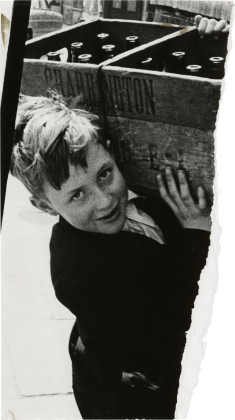David Bailey: For Real review – 'A palimpsest of post-war London life'
You can take David Bailey out of the East End, but you can’t take the East End out of David Bailey: in this new exhibition, even his portraits of elder Delhi men evoke the moustachioed hipsters of Kingsland Road.
Bailey: For Real at Daniel Blau London, one of three Bailey shows held internationally by the gallery in 2014, focuses on the more gritty, yet intimate aspects of his oeuvre: more like a carpenter’s sawdust than his recent glamorous National Portrait Gallery retrospective Stardust. “The East End personifies London for me – or, it did – because it was where I was brought up,” he once told the BBC. “I like change; I like the way it morphs into something else.”
Best known for his 1960s fashion photography, Bailey was born in Leytonstone in January 1938, into a rag-tag trade: the son of a tailor. His mother was born in Bow, his father in Hackney, his grandfather in Bethnal Green, and his genealogy from there – as far as records go – traces to Whitechapel. So, although his blossoming career took him around the globe, Bailey made frequent trips back to the East End.
The prints on show are certainly not an exclusive coup: Mick Jagger and his chiselled cheekbones make an appearance, alongside several portraits of Bailey’s famous friends, but we’ve seen it all before, and quite recently. What the exhibition does offer is a morphed, oblique perspective both on individual images, and the photographer’s work as a whole. Everything on show is presented on torn, imperfect pieces of glossy fibre photographic paper: each is uniquely frayed and shredded by Bailey’s own hands. It renders not only the tactile process of image-making more personal, but also cuts much of the familiar images we know: zooming in closely, it increases the proximity to and intensity of the subjects.
Bethnal Green (1961) depicts a young boy almost buckling under the weight of a crate of Charrington beer from the local brewery. East End (1961) is a complex shot of a pub window; an attractive barmaid pulls a pint, while lines of acid-etched words in the window contrast with an advertising hoarding message in the reflection. One image portrays a tattoo of the Kray twins – the notorious East London gangsters that befriended Bailey – itself based on an iconic portrait he once took of them. The exhibition also shows a bleak side of the capital’s east here. Children explore amongst masses of sacks strewn chaotically in one photograph, while another shows a dilapidated, ramshackle building on Viaduct Street, just a stone’s throw away from where Bethnal Green tube now is. Bailey himself was blown out of his home by the Luftwaffe.
These grainy rolls of aged black-and-white celluloid are reminiscent of George Brassai’s candid street photography in Paris. They are very much like relics, shown here in mounted boxes rather than frames, and are a palimpsest of post-war London life, as well as a few ventures abroad. However, while they do provide an interesting angle on Bailey’s work, the exhibition – in a year that has comprehensively surveyed the photographer – is relatively lightweight.
Bailey: For Real is at Daniel Blau Gallery, 51 Hoxton Square, N1 6PB until 28 June.

